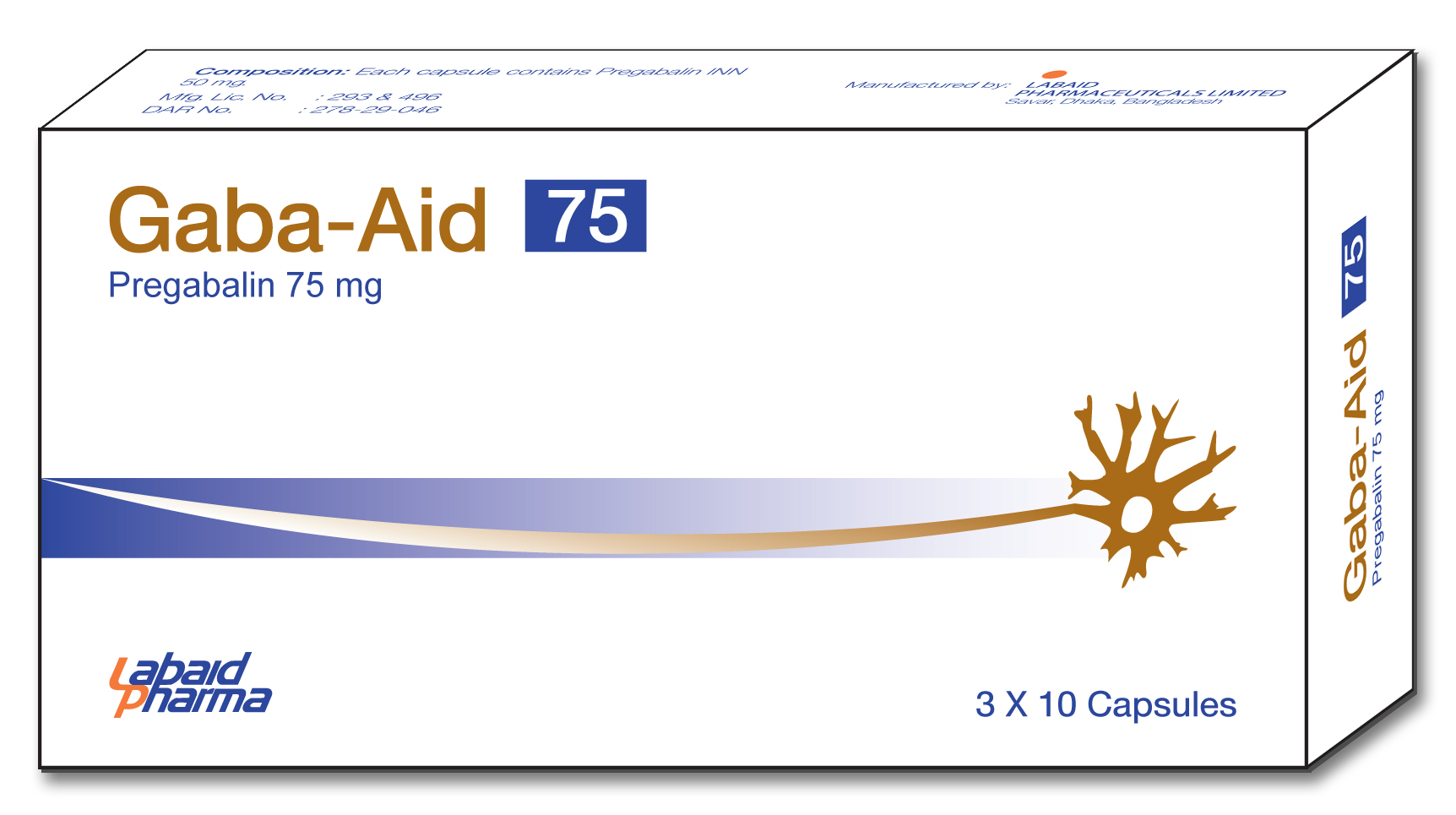Gaba-Aid 75mg

Generic : Pregabalin
Therapeutic : Pregabalin
Gaba-Aid
Pregabalin
Composition :
Gaba-Aid 75 Capsule : Each capsule contains Pregabalin INN 75 mg.
Description :
Pregabalin is a structural derivative of the inhibitory neurotransmitter gamma-amino butyric acid (GABA). It does not bind directly to GABA A, GABA B, or benzodiazepine receptor. It is inactive at serotonin & dopamine receptors and does not inhibit dopamine, serotonin or noradrenaline reuptake. It binds with high affinity to the alpha-2-delta site in central nervous system tissues. Pregabalin oral bioavailability is 90% and is independent of dose. It is eliminated from the systemic circulation primarily by renal excretion as unchanged drug with a mean elimination half-life of 6.3 hours in subjects with normal renal function.
Indications :
Pregabalin is indicated for the management of neuropathic pain associated with diabetic peripheral neuropathy and management of post-herpetic neuralgia. It is also indicated for the adjunctive therapy for adult patients with partial onset seizures. It can be used for the management of fibromyalgia.
Dosage and Administration :
Neuropathic pain associated with diabetic peripheral neuropathy: The maximum recommended dose of Pregabalin is 100 mg three times a day (300 mg/day) in patients with creatinine clearance of at least 60 mL/min. Dosing should begin at 50 mg three times a day (150 mg/day) and may be increased to 300 mg/day within 1 week based on efficacy and tolerability.
Post-herpetic neuralgia: The recommended dose of Pregabalin is 75 to 150 mg two times a day, or 50 to 100 mg three times a day (150 to 300 mg/day) in patients with creatinine clearance of at least 60 mL/min. Dosing should begin at 75 mg two times a day or 50 mg three times a day (150 mg/day) and may be increased to 300 mg/day within 1 week based on efficacy and tolerability.
Adjunctive therapy for adult patients with partial onset seizures: Pregabalin at doses of 150 to 600 mg/day has been shown to be effective as adjunctive therapy in the treatment of partial onset seizures in adults. The total daily dose should be divided and given either two or three times daily. In general, it is recommended that patients be started on a total daily dose no greater than 150 mg/day (75 mg two times a day or 50 mg three times a day). Based on individual patient response and tolerability, the dose may be increased to a maximum dose of 600 mg/day.
Management of Fibromyalgia: The recommended dose of Pregabalin for fibromyalgia is 300 to 450 mg/day. Dosing should begin at 75 mg two times a day (150 mg/day) and may be increased to 150 mg two times a day (300 mg/day) within 1 week based on efficacy and tolerability. Patients who do not experience sufficient benefit with 300 mg/day may be further increased to 225 mg two times a day (450 mg/day).
Pregabalin can be taken without regard to meals.
Side Effects :
The most common side effects include dizziness, somnolence, dry mouth, edema, blurred vision, weight gain and abnormal thinking.
Use in Special Group :
Pregnancy: Pregnancy category C. So it should only be used if potential benefit justifies the potential risks to the fetus.
Lactation: It is not known if Pregabalin is excreted in human milk; it is, however, present in the milk of rats. So it should be used in nursing mother only if there is a clear benefit over the risk.
Paediatric Use : The safety and efficacy of Pregabalin in paediatric patients have not been established.
Contraindication :
Pregabalin is contraindicated in patients with known hypersensitivity to Pregabalin or any of its components.
Precautions :
Discontinuation of Pregabalin without tapering may produce insomnia, nausea, headache and diarrhea. So it should be tapered gradually over a minimum of 1 week rather than discontinued abruptly. Creatinine kinase may be elevated if treated with Pregabalin. It should be discontinued rapidly if myopathy is diagnosed or suspected or if creatinine kinase is elevated markedly.
Drug Interaction :
There are no significant interactions between Pregabalin and other antiepileptic drugs like Carbamazepine, Valproic acid, Lamotrigine, Phenytoin, Phenobarbital, and Topiramate. Co-administration of Pregabalin with the oral contraceptives like norethisterone and ethinyl oestradiol does not influence the steady state pharmacokinetics of either agent. Pregabalin may potentiate the effets of Ethanol and Lorazepam.
Storage :
Keep away from light and store below 30o C. Keep out of the reach of children.
Commercial Pack :
Gaba-Aid 50 Capsule: Each box contains 3 X 10 capsules in blister pack.
Gaba-Aid 75 Capsule: Each box contains 3 X 10 capsules in blister pack.
Download Product Manual
Back


